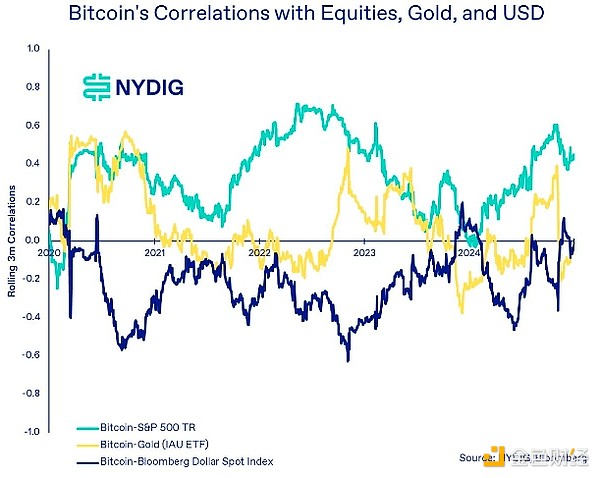
Author: Marie Poteriaieva, CoinTelegraph; Compiler: Deng Tong, Golden Finance
When to buy and when to sell Bitcoin is a decision that still confuses investors. With an ever-increasing number of factors affecting price, developing a method to consistently avoid losses and generate profits is critical for this highly volatile asset.
Recently, Bitcoin analyst and Cane Island Digital founder Timothy Peterson shared a cheat sheet of 8 macroeconomic factors that influence Bitcoin prices. Let’s take a look at the top 3 indicators, understand how they relate to Bitcoin price, and gain insight into the best buying and selling opportunities.
USD Index (DXY)DXY measures the value of the U.S. dollar against a basket of major currencies. It is affected by factors such as interest rates, geography, economic conditions, and foreign exchange reserves held in U.S. dollars.
A stronger DXY tends to have a negative impact on the price of Bitcoin. Conversely, when confidence in the index weakens, investors turn to risk assets, stocks and Bitcoin. This inverse relationship has existed for years and will continue through 2024, as recent NYDIG research shows.
Bitcoin's correlation with stocks, gold and the U.S. dollar. Source: NYDIG, Bloomberg
The U.S. Dollar Index has been trending upward since September 2024, reaching 110, its highest level in more than two years. Some analysts believe this signals a bearish outlook for Bitcoin. However, the rally is approaching long-term resistance, according to Michael Boutros, senior technical strategist at Forex.com. If this resistance level holds, it could reverse the trend, creating a more favorable environment for Bitcoin.
The U.S. Dollar Index has fallen 1.27% since peaking on January 13, but incoming President Trump could reverse that trend, depending on his Cabinet.
Fed Benchmark Rates and BitcoinFederal Reserve interest rates affect borrowing costs across the United States. Falling interest rates make borrowing cheaper, stimulating demand for risky assets. Conversely, rising interest rates tend to shift investor preferences toward income-generating assets such as bonds.
Bitcoin is also considered a risky asset. Researchers at Swiss bank Piguet Galland studied the long-term correlation between BTC and interest rates.
Bitcoin price and federal funds rate changes over time. Source: Piguet Galland
The picture above shows that after the epidemicA negative correlation emerged as BTC surged to cycle highs near $69,000 following the Era rate cut. This was followed by a significant rate hike in 2022, during which BTC fell to cycle lows of $16,000. This pattern suggests that Bitcoin is still viewed as a risk asset.
In addition to the Federal Open Market Committee (FOMC), which usually meets eight times a year, traders also use other economic indicators such as the Consumer Price Index (CPI) to influence Bitcoin prices and market inflation expectations. negative correlation data points.
When trading monthly CPI releases, market expectations often matter more than the raw numbers. For example, CPI for December 2024 showed an annual inflation rate of 2.9%, in line with market expectations. Core CPI, which excludes food and energy, was 3.2%, better than expectations for 3.3%. While still above the Fed's 2% target, it brought some relief to markets. Immediately following the news, the S&P 500 rose 1.83%, the Nasdaq 100 rose 2.3%, and Bitcoin gained 4.3%.
So far, for Bitcoin, as quant market analyst Benjamin Cowen puts it, "within inflation, good news is good news." Falling inflation tends to push BTC higher. However, there is another side to Bitcoin – its role as digital gold, often touted as a hedge against inflation. In this paradigm, rising inflation should push BTC higher as more people turn to Bitcoin to protect against a declining dollar. As Bitcoin gains popularity, this scenario may become a reality, reversing the current correlation.
The impact of bond yields on BitcoinBond yields are directly related to Federal Reserve interest rates and inflation and are another important indicator for Bitcoin traders. Low Risk The high yields on bonds may make riskier assets like Bitcoin less attractive that do not produce income.
US 10-Year Treasury Bond vs. BTC/USD. Source: MarketWatch, Coinbase
U.S. long-term bond yields have been rising since December 2024, reaching 4.77%, the highest level since 2023. The increase came despite cautious interest rate cuts by the Federal Reserve, raising concerns that inflation could spike. Bitcoin price movements have mostly been negatively correlated with bonds during this period, confirming this theory.
Bonds are also directly related to the concept of debt. Increased supply can lead to higher yields when more debt is issued (more bonds are sold) to finance spending. If debt reaches unsustainable levels, there is a risk of the dollar depreciating. United States since 2020Since then, $13 trillion in debt has been added, which is troubling news for the economy as well as Bitcoin. However, in the long term, this may increase interest in Bitcoin as an alternative currency.
Bridgewater Associates CEO Ray Dalio recognizes this possibility. Speaking at Abu Dhabi Financial Week, the billionaire said he preferred "hard currency" to debt investments, saying: "I want to stay away from debt assets like bonds and debt and hold some gold and Bitcoin etc. Hard currency."
Dalio pointed out that rising global debt may reduce the value of fiat currencies and predicted that a debt crisis is inevitable. Therefore, there may be situations where high bond yields indicate that the economy cannot sustain its own debt. This in turn could reverse the current correlation between Bitcoin and bonds.











